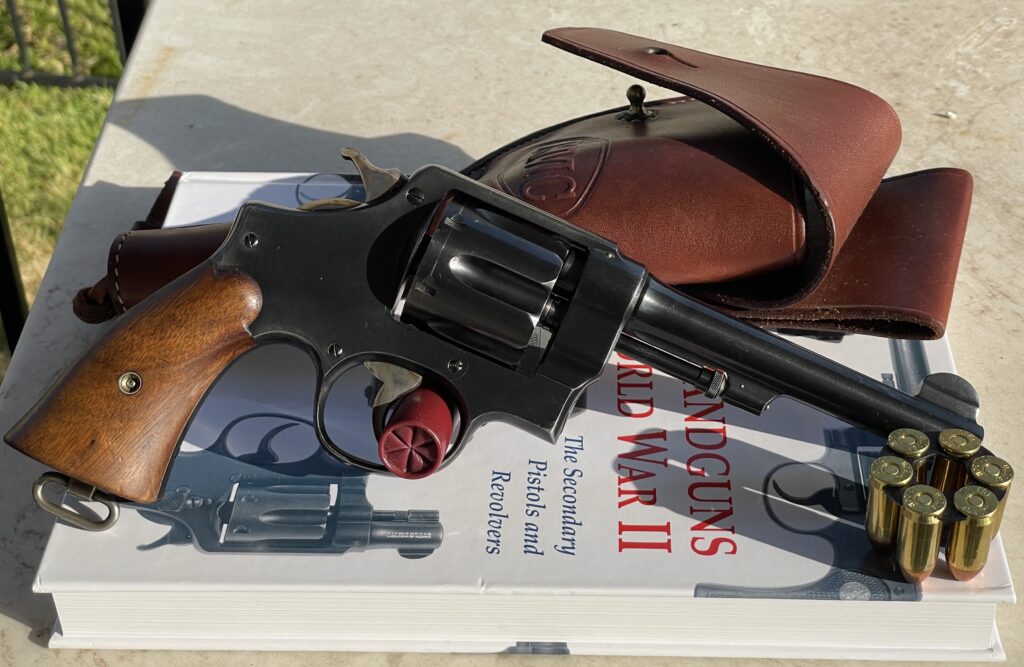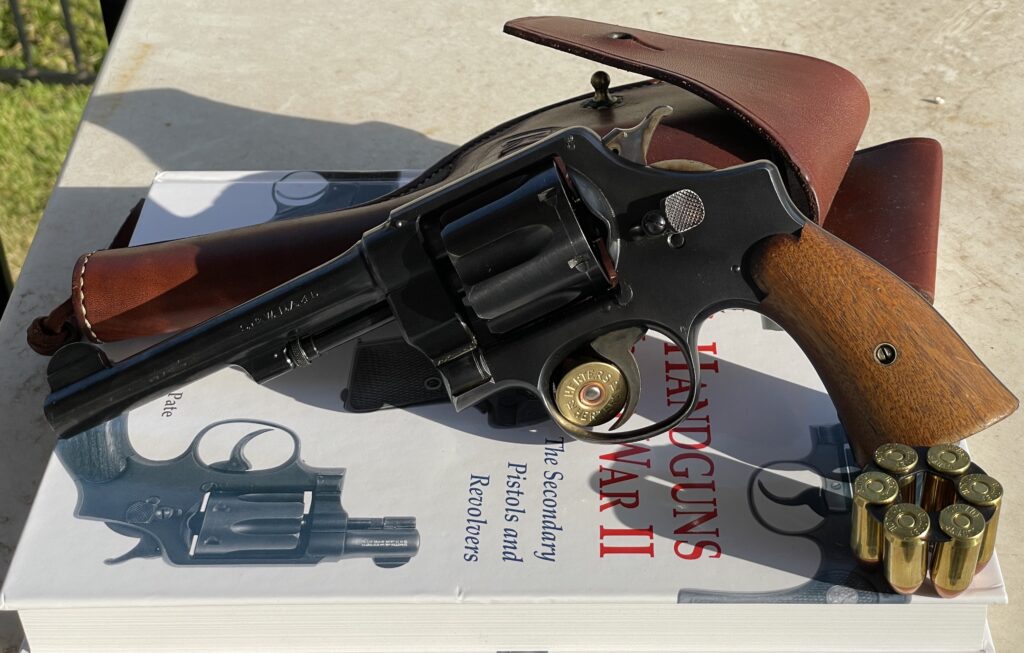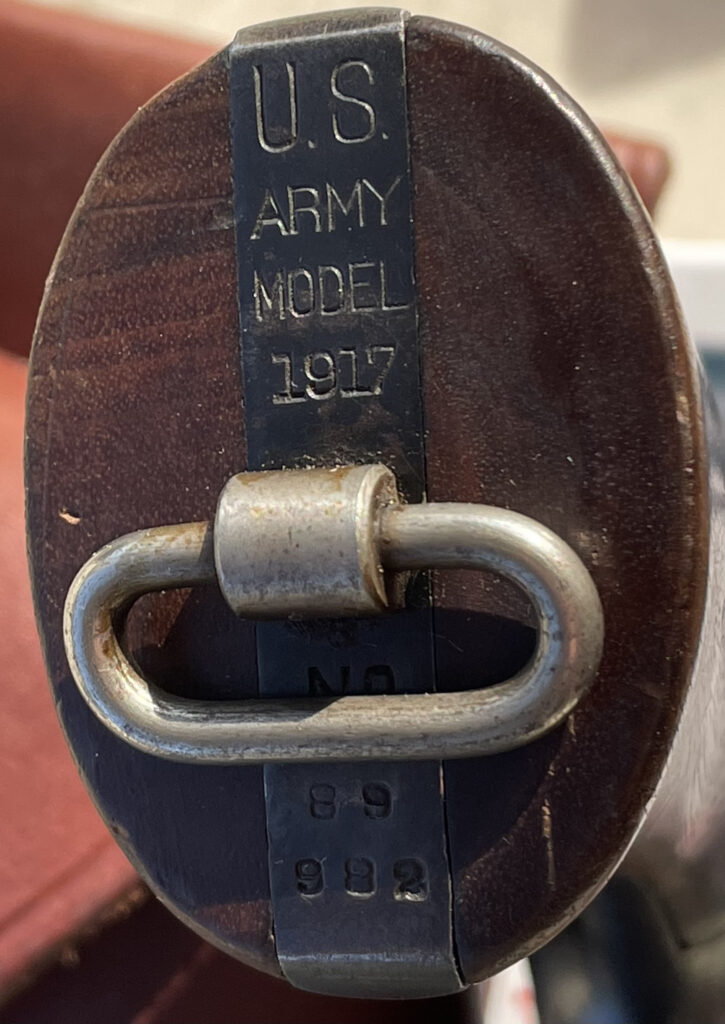Finally. The position of the sun, the condition of the back porch, and all the other things going on in my life lined up, and I can bring you the senses shattering part two of “Day of the .45”.
The same day I picked up my CMP 1911, I also took a second gun off layaway. It was also chambered in .45 ACP, and also has a military background. It had been sitting in layaway purgatory for a few months, and I didn’t take out before then because holidays.
But once the holidays passed, I was free to buy things, and had the last tranche of funds available to take it home. After the jump, more history. And some pictures…
In the beginning, approximately 1908, Smith and Wesson introduced the Hand Ejector First Model. This was a large heavy revolver designed and chambered for big-bore cartridges like the .44 Special. Some people refer to this gun as the “Triple Lock”, because the cylinder locked into the frame in three places, and think it is one of the finest revolvers ever made.
The Hand Ejector First Model evolved into the Second Model, which dropped one of the three locks. This has made a lot of people very unhappy and been widely regarded as a bad move. Some people say S&W did this to save money. Other people say S&W did this because the Hand Ejectors were popular with the military, and dropping one of the locks was intended to keep the guns from jamming up with mud and crud in the field. Both are probably right. The Second Model evolved into the Third Model, and the evolutionary tree goes on from there. The S&W N-frame, basis for the original .357 Magnum and .44 Magnum (and still in the lineup today) is a direct descendant of the original Hand Ejector First Model.
Recall what I said above, about crud and mud and dropping the third lock? The British bought 70,000 Second Models (and, before that, some First Models), chambered in the .455 Webley cartridge, which was their standard sidearm round at the time. The .455 Webley is a little different dimensionally than the .45 ACP, but not that much different, so chambering the Second Model in .45 ACP seemed like a logical development. And there were folks who anticipated that the United States would enter World War I, and that the military would need guns: while the 1911 was standard issue at the time, Colt was still ramping up production, and there just weren’t enough to go around.
There was just one problem: because the .45 ACP doesn’t have a rim (as opposed to other rounds designed for revolvers), it was difficult to make the Second Model eject spent cartridges. Fortunately, Joseph Wesson of the S&W factory had been working on this problem, and developed the moon clip. I have written a little about this aspect of history before, and quite likely will again, so I’m giving the history of the moon clip a very cursory treatment here.
The .45 ACP Second Model in .45 ACP became known as the US Model of 1917 (or the “.45 Hand Ejector U.S. Army, Model 1917” as the Standard Catalog refers to it). Both S&W and Colt produced large numbers of these during the war: “According to Bruce Canfield’s book, US Infantry Weapons of World War II, the government bought approximately 153,000 of the S&W version, and approximately 150,000 of the Colt one.” During the war, the government actually took over management of S&W (and I believe Colt as well) to make sure they were cranking out guns at maximum efficiency.
(The Colt equivalent was the Colt New Service revolver in .45 ACP. I specify that because the military had previously issued the New Service in .45 Colt as the Model of 1909, but replaced those with the 1911 two years later.)
After WWI, Smith and Wesson continued to produce the 1917 commercially until 1949. There were apparently a small number produced with adjustable sights, though I don’t think that was ever an official product: more of an experiment that S&W didn’t feel worked out.
The US government still had a fair number of these guns in inventory post-WWI. During WWII, they were issued as a secondary handgun. I have seen references to them being used by guards, and also being popular among tankers and folks fighting in the Pacific jungles. They also saw some use in the Vietnam War: the references I have seen say they were used by “tunnel rats” and some MACV-SOG personnel.
Both sides now:
I really like the way that second one came out. You can actually read the markings.
Yes, it does have an official US Government property mark. I suppose those could be faked, but why bother? And the other details check out.
And a lanyard loop, like every good service weapon should have.
This example was shipped in August of 1918, per Roy Jinks and oldguns.net. I want to believe this saw service during the war, but I think that may be pushing things a bit. August 1918 is kind of late in the war, and this gun just looks too darn nice to have spent time in a trench. Someone I know suggested it might have been issued to a REMF.
For a military gun, produced in high volume during wartime, it has a much nicer blue than I’d expect. And I can’t find any wear on it.
It came with three moon clips, and the holster. I’ve been told that the holster is a reproduction, not original, but I don’t care. It still looks nice.
So I have a 1911, and a Model of 1917. If my goal is to collect all the modern service issue sidearms, what should I get next? I don’t have a Beretta M9 or a SIG M17. Yet. On the other hand, a vintage Colt New Service (the Model of 1909) would be fun. I have a semi-irrational fondness for the .45 Colt. And if I found a Colt Model of 1917 at a good price, I’d throw that in as well.
=======
Side note:
There’s a very nice gentleman on the CMP Forums who will run down shipping dates and other information on your CMP 1911. According to him, mine shipped in January of 1945. (I don’t know why oldguns.net says 1944, but January of 1945 is close enough to December 1944. It could be a difference in when the serial number was stamped vs. when the gun actually went out of the factory, or some other reason.)
He also believes the Ithaca slide was added during a rebuild in the late 1940s, as the Ithaca slides were pretty much gone at the time of the 1980s and 1990s rebuilds.
Sources for this post, and for some more information on the Model of 1917:
Campbell, Dave. “A Look Back at the Smith & Wesson Model 1917.” American Rifleman, www.americanrifleman.org/content/a-look-back-at-the-smith-wesson-model-1917/. Accessed 9 Feb. 2023.
Canfield, Bruce M. “Valuable Service: The U.S. Model Of 1917 Revolvers”. American Rifleman, https://www.americanrifleman.org/content/valuable-service-the-u-s-model-of-1917-revolvers/. Accessed 21 Jul. 2023.
Pate, Charles W. U.S. Handguns of World War II. Andrew Mowbray Pub, 1998.
Supica, Jim, and Richard Nahas. Standard Catalog of Smith & Wesson 4th Edition. Gun Digest Books, An Imprint Of F+W Media, Inc, 2016.
Venturino, Mike “Duke”. “1917 Classics.” American Handgunner, 7 Feb. 2023, https://americanhandgunner.com/handguns/1917-classics/. Accessed 9 Feb. 2023.
“M1917 Revolver.” Wikipedia, 31 May 2022, en.wikipedia.org/wiki/M1917_Revolver.




I took my wife to see Oppenheimer today. We haven’t gone to see a movie in several years, and while this seemed to be a strange choice for our first time back, my wife really wanted to see it, and enjoyed it. She forbade me from telling her anything about Oppenheimer the man before the movie, so it was all new to her. And I am certain that much of it was artistic license.
The problem with this and many other new releases, is that the movie was in total 3 full hours long. I run into this problem on a lot of the newer movies that I screen online from some of the services that I have subscribed to in the past.
While there, we did see a deal for 19.95 a month, which allows you to attend 3 movies a week for free. If you like to go to movies that is a very good deal, as the tickets for this movie for the two of us were a few cents over 20 bucks. I told my wife that she has to look and see if there are enough movies to make it a worthwhile thing. I am thinking that is, and we might go that route. I no doubt can find at least a movie a week to go to, which will make the investment pay for itself.
I also cleaned my Ruger SR9c and put it back in my holster for CCW this week. I have been carrying a S & W 3913, a double action pistol from the 1990’s, and a first semi auto for many police depts. I like the gun, but I did get advice some time ago from Roy Huntington to carry the more modern gun, due to the reliability factor, what I consider a good idea, but I do like the idea of a traditional double action as a carry gun. But the Ruger does have a manual safety, which I do prefer.
In any case, best wishes to all, and a great last full week of July.